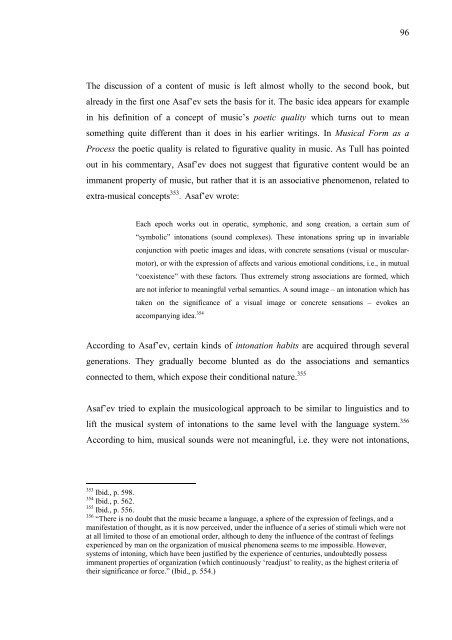Boris Asaf'ev and the Soviet Musicology - E-thesis
Boris Asaf'ev and the Soviet Musicology - E-thesis
Boris Asaf'ev and the Soviet Musicology - E-thesis
You also want an ePaper? Increase the reach of your titles
YUMPU automatically turns print PDFs into web optimized ePapers that Google loves.
The discussion of a content of music is left almost wholly to <strong>the</strong> second book, but<br />
already in <strong>the</strong> first one Asaf’ev sets <strong>the</strong> basis for it. The basic idea appears for example<br />
in his definition of a concept of music’s poetic quality which turns out to mean<br />
something quite different than it does in his earlier writings. In Musical Form as a<br />
Process <strong>the</strong> poetic quality is related to figurative quality in music. As Tull has pointed<br />
out in his commentary, Asaf’ev does not suggest that figurative content would be an<br />
immanent property of music, but ra<strong>the</strong>r that it is an associative phenomenon, related to<br />
extra-musical concepts 353 . Asaf’ev wrote:<br />
Each epoch works out in operatic, symphonic, <strong>and</strong> song creation, a certain sum of<br />
“symbolic” intonations (sound complexes). These intonations spring up in invariable<br />
conjunction with poetic images <strong>and</strong> ideas, with concrete sensations (visual or muscularmotor),<br />
or with <strong>the</strong> expression of affects <strong>and</strong> various emotional conditions, i.e., in mutual<br />
“coexistence” with <strong>the</strong>se factors. Thus extremely strong associations are formed, which<br />
are not inferior to meaningful verbal semantics. A sound image – an intonation which has<br />
taken on <strong>the</strong> significance of a visual image or concrete sensations – evokes an<br />
accompanying idea. 354<br />
According to Asaf’ev, certain kinds of intonation habits are acquired through several<br />
generations. They gradually become blunted as do <strong>the</strong> associations <strong>and</strong> semantics<br />
connected to <strong>the</strong>m, which expose <strong>the</strong>ir conditional nature. 355<br />
Asaf’ev tried to explain <strong>the</strong> musicological approach to be similar to linguistics <strong>and</strong> to<br />
lift <strong>the</strong> musical system of intonations to <strong>the</strong> same level with <strong>the</strong> language system. 356<br />
According to him, musical sounds were not meaningful, i.e. <strong>the</strong>y were not intonations,<br />
353 Ibid., p. 598.<br />
354 Ibid., p. 562.<br />
355 Ibid., p. 556.<br />
356 “There is no doubt that <strong>the</strong> music became a language, a sphere of <strong>the</strong> expression of feelings, <strong>and</strong> a<br />
manifestation of thought, as it is now perceived, under <strong>the</strong> influence of a series of stimuli which were not<br />
at all limited to those of an emotional order, although to deny <strong>the</strong> influence of <strong>the</strong> contrast of feelings<br />
experienced by man on <strong>the</strong> organization of musical phenomena seems to me impossible. However,<br />
systems of intoning, which have been justified by <strong>the</strong> experience of centuries, undoubtedly possess<br />
immanent properties of organization (which continuously ‘readjust’ to reality, as <strong>the</strong> highest criteria of<br />
<strong>the</strong>ir significance or force.” (Ibid., p. 554.)<br />
96

















